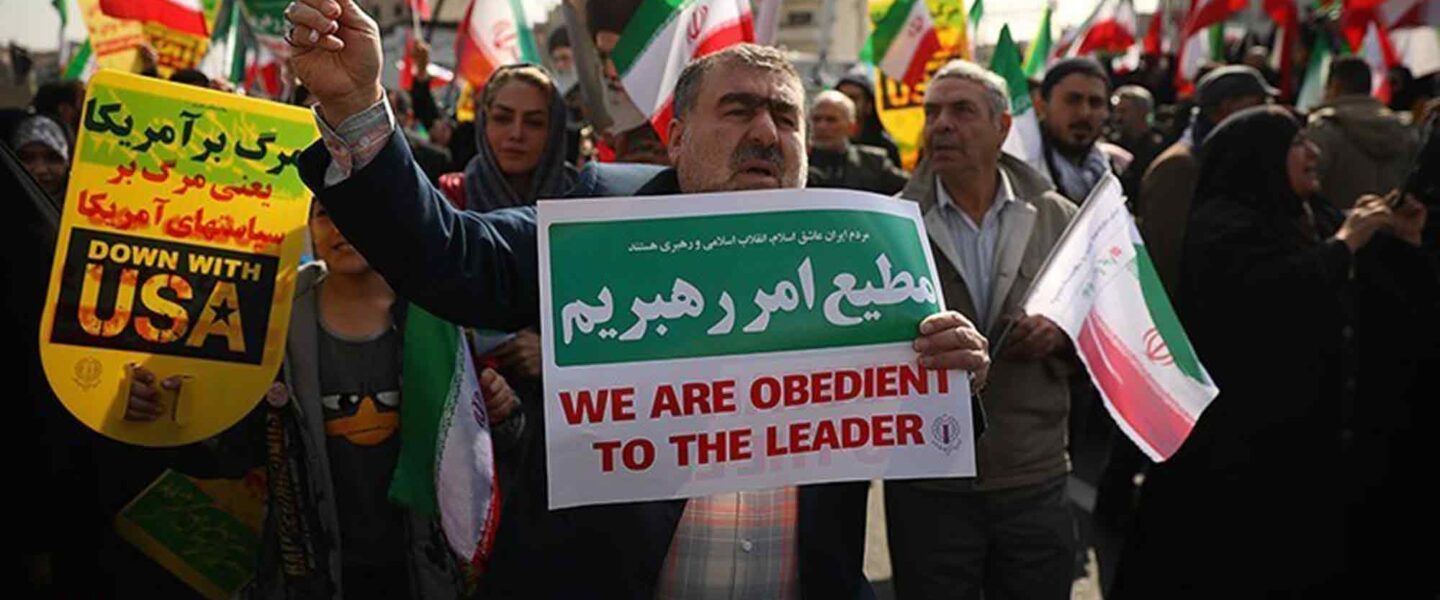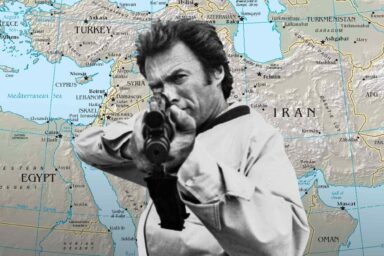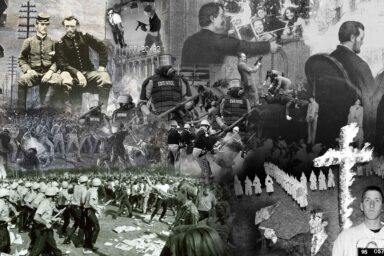A regime that once ruled through fear now faces its own collapse. Shay Khatiri explains why this moment changes everything — and what happens next.
What happens when a regime built on three pillars of legitimacy loses two of them entirely — and faces the destruction of the third? For the Islamic Republic of Iran, that moment may have arrived.
This week on the WhoWhatWhy podcast, we’re joined by Shay Khatiri, a senior fellow at the Yorktown Institute and a scholar at Johns Hopkins School of Advanced International Studies. Khatiri writes the substack The Russia-Iran Files.
Khatiri didn’t study Iranian oppression from academic journals — he lived under it, resisted it, and escaped it. As a teenager, he rejected recruitment by the very Basij militia forces he would later fight against in Tehran’s streets during the 2009 Green Revolution.
He felt rubber bullets shatter his wrist and hid in strangers’ houses while regime thugs prowled outside, waiting to arrest him.
Today, Khatiri brings that personal history to bear on one of the most urgent questions in international relations: whether Israel’s recent military actions have created an unprecedented opportunity for Iranian regime change — or set the stage for regional catastrophe.
In this conversation, Khatiri argues that Israel is finally doing “what we should have done decades ago,” calling recent strikes both overdue and admirable while lamenting America’s abdication of global responsibilities.
He reveals how the Islamic Republic has systematically lost the religious and economic legitimacy that once sustained it, leaving only its nuclear program as the final pillar keeping the regime standing. He argues that traditional American diplomacy has been doomed from the start, because any meaningful nuclear deal would politically destroy the very leadership we’re negotiating with.
Khatiri outlines specific steps the United States and Israel could take to support Iranian opposition forces — while warning of the devastating consequences if the regime collapses without proper preparation for what comes next.
*For listeners who may find Khatiri’s accent and some recording issues challenging to follow, a full transcript is available below.
 Apple Podcasts
Apple Podcasts Google Podcasts
Google Podcasts RSS
RSS
Full Text Transcript:
(As a service to our readers, we provide transcripts with our podcasts. We try to ensure that these transcripts do not include errors. However, due to a constraint of resources, we are not always able to proofread them as closely as we would like and hope that you will excuse any errors that slipped through.)
Jeff: Welcome to the WhoWhatWhy Podcast. I’m your host, Jeff Schechtman.
The corridors of power in Washington have long been haunted by a single, intractable question: what to do with a regime that thrives on confrontation, draws strength from isolation, and treats compromise not as diplomacy, but as defeat.
For over four decades, five consecutive American administrations have grappled with the Islamic Republic of Iran, each believing they possess the key to unlocking this geopolitical Gordian knot. Each has been wrong.
Today, we’re joined by someone who brings a perspective as rare as it is essential—lived experience transformed into strategic insight.
Shay Khatiri didn’t just study the Iranian regime from the comfortable distance of think tank offices or university seminars. He lived under it, resisted it, fled from it, and now analyzes it with the cold clarity that only comes from having your own skin in the game.
As a child, Khatiri was recruited by the very Basij militia forces he would later fight against in the streets during the 2009 Green Revolution. As a student, he was reported by regime informants simply for flirting with a classmate. As a young man, he felt rubber bullets shatter his wrist and hid in strangers’ homes while Basij thugs waited outside to arrest him.
These aren’t abstract policy considerations for Khatiri—they’re memories that still quicken his pulse when Israeli strikes hit the headquarters of his former tormentors. But what makes his analysis truly compelling isn’t just his personal history; it’s how he’s channeled that experience into a framework that challenges nearly every assumption underlying American policy toward Iran.
While Washington debates engagement versus containment, Khatiri argues we’re asking the wrong questions entirely. The issue isn’t whether Iran will negotiate away its nuclear program; it’s why a regime that derives its legitimacy from resistance to America would ever genuinely do so.
In his writings, Khatiri has emerged as one of the most provocative voices in foreign policy analysis. He argues that Khamenei’s greatest fear isn’t military defeat, but looking weak-willed to a shrinking yet critical base of support.
Khatiri has long suggested that Israel—not America—may be the key to Iranian liberation, a historical irony tracing back to Cyrus the Great freeing the Jews from Babylon 25 centuries ago.
Today, with renewed repression simmering beneath the surface of Iranian society, and a fragile ceasefire in place, the questions Khatiri raises have never been more urgent. Are we witnessing the last gasp of a dying regime or the final sprint toward a nuclear-armed theocracy? Will Israel’s military action succeed where American diplomacy has failed? And what happens to American strategy if the very deal we seek might destroy the regime we’re negotiating with?
To address all of this, it’s my pleasure to welcome Shay Khatiri back to the program. Shay, thanks so much for joining us here on the WhoWhatWhy Podcast.
Shay: Hey Jeff, thanks for having me.
Jeff: Thank you for joining us today. I want to start by asking about your reaction to Israel’s initial strike on Iran a couple of weeks ago. I know you’ve written passionately about it in your Substack.
Shay: My reaction was complex and emotional, and at times contradictory. First, as an American policy professional, I thought Israel was doing what the U.S. should have done a decade ago. It reflects an abdication of global responsibility by the United States—something we see in Ukraine, now in the Middle East, and I worry we’ll soon see in Asia. Israel deserves admiration for stepping up.
Yet there’s also a deeply personal aspect. War inevitably brings suffering. The greatest suffering will be the regime’s revenge against the Iranian people for failing to defend it. These conflicting thoughts coexist for anyone who sees Iran’s nuclear ambitions as a genuine threat yet sympathizes deeply with the Iranian people. Ultimately, I blame the United States for allowing this crisis to fester.
Jeff: At what point would you have liked to see the U.S. take bolder action? How far back should we go?
Shay: Of course, hindsight is 20/20. But evidence was always there that this regime was incapable of genuine reform. The nuclear program wasn’t merely about maximizing foreign policy power; it was fundamental to the regime’s legitimacy. Stephen Hadley once said there are two clocks—one counting down to Iran acquiring the bomb, the other to the regime collapsing. Waiting for the regime to collapse on its own was misguided because this regime was never going to fall voluntarily. It’s totalitarian and willing to kill its own people.
By around 2015, after the JCPOA, it was obvious that Iran wasn’t changing its conduct. Even President Obama admitted that by 2030, once the JCPOA restrictions ended, Iran would be only a week away from a nuclear weapon. By then, military action should have been seriously considered.
Jeff: Talk about the significance of the nuclear program, both as an existential threat and as a source of legitimacy for the regime.
Shay: After the 1979 Islamic Revolution, Khomeini’s regime rested on three pillars: populist economic policies, religious conservatism, and aggressive anti-American and anti-Zionist foreign policy.
By the 2000s, the regime had lost popular support in the first two areas. Economic inequality worsened dramatically, and religious adherence collapsed. The regime compensated by intensifying its foreign confrontations, particularly through its nuclear program. As the U.S. and Israel began dismantling Iran’s proxies—starting with Soleimani’s killing in 2020—the nuclear program became the last remaining source of legitimacy.
Jeff: Given those changes—the demographic shifts, cultural pushback, and apparent military weaknesses—where does the regime stand today?
Shay: In disarray. I don’t think anyone can say precisely where it stands—not even the regime itself. They’re likely still trying to analyze their own position. There’s clearly a legitimacy crisis. Keep in mind, revolutionary regimes usually become more extreme over generations, not less. We saw this historically with the Soviet Union. Each subsequent generation after Lenin and Stalin became more dogmatic because they had no need to compromise to achieve power. They were accustomed to absolute authority and had been indoctrinated into extremism. It took multiple generations before Soviet leaders realized their politics were unsustainable.
Similarly, Iran’s younger revolutionaries today are more radical than the first generation. Current reformists, like Rouhani, who participated directly in the revolution, now seem moderate compared to radicals who grew up entirely under revolutionary indoctrination, like Ahmadinejad. Future revolutionary leaders could well accuse the current regime of betraying revolutionary ideals and push for greater extremism.
Khamenei now faces a critical moment. Regime loyalists have to decide whether to remain patient and wait for his death, hoping for a smoother transition, or challenge him directly for failing the revolution. There’s a core 10 to 20 percent of the population supporting the regime; their reaction to recent events, especially Israel’s strikes, will be crucial. Will they see it as catastrophic failure or as a rallying point?
The overwhelming majority of Iranians oppose the regime but lack weapons and institutional power. In 2019, when people took to the streets, the regime massacred about 1,500 protesters within days, even firing from helicopters. An unarmed civilian uprising alone can’t overthrow such a ruthless regime. The critical factor isn’t public opposition, but whether the armed minority defending the regime remains loyal. If those defenders lose faith, the system could collapse quickly.
Jeff: Given all of that, what specific actions should the U.S. or Israel be taking right now?
Shay: First, overtly degrade Iran’s internal security apparatus. Israel has already targeted institutions like the Ministry of Interior and internal security forces—organizations used primarily against Iranian citizens, not foreign adversaries. These strikes are clearly designed to diminish the regime’s capacity to suppress domestic unrest. But more overt and direct action could be undertaken, especially by the United States, to further cripple these internal security mechanisms. Providing secure communication technologies to protesters, ensuring the regime cannot shut down internet access during protests, and possibly even establishing temporary no-fly zones to stop regime helicopters from attacking civilians, would be highly effective.
Second, engage directly and seriously with the Iranian opposition abroad to establish credible transitional leadership. The protest movement currently lacks a unified leader or clear direction, leaving it vulnerable and disorganized. If the regime collapses suddenly, the absence of a clear alternative could trigger civil war or prolonged chaos. Preparing credible opposition leadership now can prevent that and stabilize a future transition.
This is something we neglected in Iraq in 2001 and 2002. The Pentagon wanted to prepare transitional governance, but internal bureaucratic opposition prevented it, leading to chaos after Saddam’s fall. Learning from that experience, it’s essential to clearly identify, train, and support Iranian opposition figures capable of stepping into leadership roles immediately after the regime’s collapse. Planning now for the “day after” is critical.
Jeff: Given all this, what timeline are we looking at? How quickly should these actions be implemented?
Shay: Now, sooner rather than later. This regime is currently at its weakest point since the Iran-Iraq War. Missing this moment could have disastrous consequences. If we hesitate, the regime might successfully rebuild its legitimacy. Worse yet, if the regime collapses without any plan in place, Iran could spiral into anarchy or civil war, creating massive refugee flows far exceeding anything seen from Syria. Tens of millions of Iranian refugees flooding into Europe would profoundly destabilize global politics, fueling far-right extremism across Europe and even here in America.
Recall how just a small number of Syrian refugees profoundly impacted European and American politics. Donald Trump’s political rise was partly fueled by reactions to Syrian refugees. Now imagine that scenario magnified by tens of millions from Iran—it’s a terrifying prospect for global stability.
Jeff: Given this moment of vulnerability, what’s your ideal scenario for actions by the U.S. or Israel right now? What specific steps should they prioritize?
Shay: Overtly degrading the regime’s internal security apparatus is essential, and Israel has already started doing this by targeting institutions like the Interior Ministry and internal security command—entities primarily responsible for domestic repression, not external threats. But the U.S. has the capability to expand this effort significantly, including supplying protestors with secure communications technology and possibly implementing no-fly zones during protests to prevent regime helicopters from attacking civilians. Iran frequently shuts down the internet to disrupt protests; ensuring uninterrupted communication channels would dramatically empower protesters.
Additionally, engaging actively and urgently with Iranian opposition abroad to identify and build credible transitional leadership is critical. The protest movement currently lacks cohesive direction and leadership, leaving it fragmented and vulnerable. Without clear leadership prepared in advance, the collapse of the regime could easily trigger civil war or prolonged chaos. That’s precisely what happened in Iraq after Saddam’s fall—due to inadequate preparation of transitional governance. We need to learn from that mistake. Planning now for the “day after” isn’t merely wise—it’s essential.
We should not just think about regime collapse itself, but the immediate aftermath. Ideally, we’d have a recognized transitional authority ready to step in the very day the regime falls, ensuring stability, minimizing humanitarian suffering, and securing the country’s weapons and institutions before chaos erupts.
Jeff: Finally, Shay, we’re almost out of time. Realistically, within what time frame does this action need to happen?
Shay: Immediately. The regime right now is at its most vulnerable point since the Iran-Iraq War. This vulnerability won’t last forever. These leaders aren’t fools—they are clever and resilient. If we delay action, the regime could recover legitimacy, reassert control, and become even harder to challenge.
The greatest risk is waiting too long and allowing Iran to collapse chaotically. Without preparation, we risk triggering catastrophic civil conflict. Tens of millions of Iranians becoming refugees would profoundly destabilize not only the region but European and American politics. Just a fraction of Syrian refugees reshaped global politics—imagine tens of millions fleeing Iran. The geopolitical, humanitarian, and political consequences would be enormous and devastating.
This is our best and possibly our last chance to act decisively and prevent those scenarios.
Jeff: Shay Khatiri, thank you so much for joining us today.
Shay: Of course. Thank you, Jeff.
Jeff: And thank you for joining us here on the WhoWhatWhy podcast. Please join us again next week. I’m Jeff Schechtman. If you enjoyed this episode, please share it and help others find it by rating and reviewing us on iTunes. You can also support this podcast and all the work we do by visiting whowhatwhy.org/donate.



